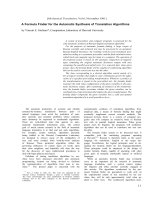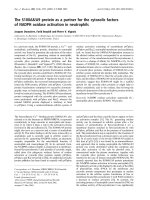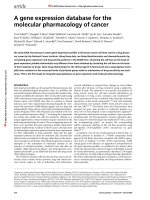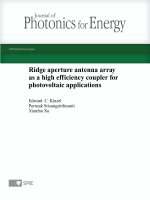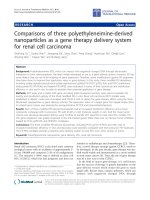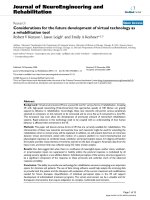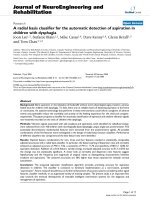Superparamagnetic nanoparticles as a recyclable heterogeneous catalyst for the direct synthesis of carbamates containing biothiazole moiety
Bạn đang xem bản rút gọn của tài liệu. Xem và tải ngay bản đầy đủ của tài liệu tại đây (517.12 KB, 7 trang )
<span class='text_page_counter'>(1)</span><div class='page_container' data-page=1>
<i>DOI: 10.22144/ctu.jen.2018.024 </i>
<b>Superparamagnetic nanoparticles as a recyclable heterogeneous catalyst for the </b>
<b>direct synthesis of carbamates containing biothiazole moiety </b>
Nguyen Kim Chung1<sub>, Tran Nhut Kien</sub>1<sub>, Dang Huynh Giao</sub>1,2<sub>, Le Thanh Dung</sub>1*<sub> and </sub>
Phan Thanh Son Nam<b>1 </b>
<i>1<b><sub>Faculty of Chemical Engineering, HCMC University of Technology, VNU-HCM </sub></b></i>
<i>2<b><sub>College of Engineering Technology, Can Tho University </sub></b></i>
<i>*<sub>Correspondence: Le Thanh Dung (email: ) </sub></i>
<b>Article info. </b> <b>ABSTRACT </b>
<i>Received 25 Nov 2017 </i>
<i>Revised 20 Dec 2017 </i>
<i>Accepted 20 Jul 2018</i>
<i>Superparamagnetic copper ferrite nanoparticles were utilized as a </i>
<i>recycla-ble heterogeneous catalyst for the cross-dehydrogenative coupling of </i>
<i>N,N-disubstituted formamides with phenols. This routine allowed the creation of </i>
<i>a hybrid benzothiazole-carbamate moiety under heterogeneous catalysis. </i>
<i>These products possess both carbamate and benzothiazole moieties, thus </i>
<i>taking profits from both structures with regard to pharmaceutical and </i>
<i>bio-logical activities. Employing a catalytic portion of thesuperparamagneti </i>
<i>cnanoparticles, hybrid benzothiazole-carbamate structures could be </i>
<i>pro-duced with reasonable yields within 2 hrs. It was possible to recover the </i>
<i>nanoparticles by simple magnetic separation, and reutilize them for the </i>
<i>re-action without a significant decline in catalytic efficiency. </i>
<i><b>Keywords </b></i>
<i>Carbamates, formamides, </i>
<i>na-nocatalysis, nanoparticles, </i>
<i>phenols </i>
Cited as: Chung, N.K., Kien, T.N., Giao, D.H., Dung, L.T. and Nam, P.T.S., 2018. Superparamagnetic
nanoparticles as a recyclable heterogeneous catalyst for the direct synthesis of carbamates
<i>containing biothiazole moiety. Can Tho University Journal of Science. 54(5): 52-58. </i>
<b>1 INTRODUCTION </b>
Catalysis has been considered as the spirit of the
chemical industry, and using heterogeneous
catalysts in the production of fine chemicals and
pharmaceuticals for straightforward catalyst
recycling is a long-established target of catalysis
<i>discipline (Cano et al., 2015; Kausik et al., 2016). </i>
‘‘Nanocatalysis’’ has emerged as an swiftly
developing field during the last decade (Purbia and
<i>Paria, 2015; Stark et al., 2015), and active </i>
nanoparticles have been explored as a link between
homogeneous and heterogeneous catalysts
<i>(Ranganath and Glorious., 2011; Zhang et al., 2014; </i>
<i>Peiris et al., 2016). If it is possible to reduce the </i>
catalyst particle size to nanometer dimensions, all of
the areas on the external surface of the catalyst
might be beneficial for the conversion, and hence its
<i>activity could be remarkably polished (Duan et al., </i>
<i>2015; Gawande et al., 2015; Sharma et al., 2015). </i>
</div>
<span class='text_page_counter'>(2)</span><div class='page_container' data-page=2>
<i>and the arylation of oxindoles (Moghaddam et al., </i>
2016).
Organic carbamates are a momentous category of
pharmaceutically and biologically alluring
compounds that customarily come about in many
pharmaceuticals, naturally bioactive products, , and
agrochemicals (Kathiresan and Velayutham, 2015;
<i>Wang et al., 2015). Established synthetic protocols </i>
employed hazardous reagents, and should be refined
<i>utilizing greener approaches (Saberi et al., 2016). </i>
Krogul and Litwinienko (2015) previously
demonstrated the synthesis of carbamates by
oxidative carbonylation between anilines and
CO/O2 mixture employing PdCl2(X<i>n</i>Py)2 complexes
as catalyst. Reddy and co-workers proposed a direct
<i>conversion of N-aryl formamides to carbamates </i>
employing hypervalent iodine (Reddy et al., 2016).
<i>Recently, Ali et al. (2015) revealed the first report </i>
of the generation of carbamates from
dialkylformamides and phenols carrying
benzothiazole directing substituents utilizing copper
acetate catalyst. These products possess both
carbamate and benzothiazole portions, thus taking
benefits from both structures with regard to
<i>biological activities. However, the catalyst could not </i>
<i>be recycled and reused. Herein, the purpose of this </i>
study is to present the synthesis of carbamates
containing benzothiazole moiety by direct coupling
<i>between phenols and N,N-disubstituted formamides </i>
employing unfunctionalized CuFe2O4
superparamagnetic nanoparticle as a robust,
<b>effective and recyclable catalyst. </b>
<b>2 MATERIALS AND METHODS </b>
The superparamagnetic nanoparticles CuFe2O4 were
supplied by Sigma-Aldrich. The material was
subsequently characterized by many analysis
protocols. In an illustrative experiment,
2-(2-hydroxyphenyl) benzothiazole (0.1136 g, 0.5 mmol)
<i>was dissolved in N,N’-diethylformamide (DEF, 1.5 </i>
ml, 19 mmol), and the solution was added into an 8
mL vial consisting of the pre-calculated quantity of
catalyst. The catalyst amount was determined with
respect to the copper/2-(benzo[d]thiazol-2-yl)
<i>phenol mole fraction. Subsequently, tert-butyl </i>
<i>hydroperoxide (tBuOOH, 70% wt. in water; 0.291 </i>
mL, 2.0 mmol) was added to the vial, and the
resulting mixture was magnetically stirred at 100o<sub>C </sub>
for 60 mins under air. After that, the reactor was
cooled down to room temperature, then diphenyl
ether (0.0851 g, 0.5 mmol) as an internal standard
was introduced to the reaction mixture. Samples
were taken, diluted with ethyl acetate (3 mL), stirred
forcefully with anhydrous Na2SO4 to remove water
residue, and analyzed by gas chromatography (GC)
<i>regarding diphenyl ether. The o-(2-benzothiazolyl) </i>
phenyl diethylcarbamate was purified using column
chromatography. The product specification was
additionally validated by 1<sub>H NMR and </sub>13<sub>C NMR. To </sub>
inspect the reusability of CuFe2O4, the nanoparticles
were separated by magnetic decantation, washed
carefully with DEF and methanol, dried in a Shlenk
line at 150o<sub>C under vacuum in 6 hrs., and reutilized </sub>
for new catalytic run.
<b>3 RESULTS AND DISCUSSION </b>
<b>3.1 Characterization of catalysis </b>
The superparamagnetic nanoparticles CuFe2O4 were
characterized by utilizing several conventional
analysis methods. X-ray powder diffraction result of
the nanoparticles showed that no impurity peak was
detected (Fig. 1). Scanning electron microscopy
(Fig. 2) and transmission electron microscopy (Fig.
3) pictures revealed that the nanoparticles possessed
diameters of less than 50 nm. A vibrating sample
magnetometer was utilized to investigate magnetic
properties of the nanoparticles, with an applied field
ranging from -15000 Oe to 15000 Oe being
explored. The magnetization curves were noticed to
be entirely reversible at room temperature, verifying
that the nanoparticles should be superparamagnetic
(Fig. 4). The magnetization curves also indicated
that the nanoparticles exhibited saturation
magnetization value of 30 emu/g.
<b>Fig. 1: X-ray powder diffractograms of the </b>
<b>CuFe2O4 nanoparticles </b>
<b>Fig. 2: SEM micrograph of the CuFe2O4 </b>
<b>nano-particles </b>
0
1000
2000
3000
4000
5000
20 30 40 50 60 70
<b>2-Theta-Scale</b>
<b>In</b>
<b>te</b>
<b>n</b>
<b>s</b>
<b>it</b>
<b>y</b>
<b> (</b>
<b>a</b>
<b>.u</b>
</div>
<span class='text_page_counter'>(3)</span><div class='page_container' data-page=3>
<b>Fig. 3: TEM micrograph of the CuFe2O4</b>
<b>nanoparticles </b> <b>Fig. 4: Magnetization curves for the CuFe</b>
<b>2O4</b>
<b>nanoparticles </b>
<b>3.2 Catalytic studies </b>
The superparamagnetic nanoparticles were
evaluated for their activity in the reaction between
2-(2-hydroxyphenyl) benzothiazole and DEF to
produce <i>o-(2-benzothiazolyl)phenyl </i>
diethylcarbamate as the major product (Fig. 5). In
this protocol, the benzothiazole acts as a directing
substituent, facilitating the cross-dehydrogenative
coupling conversion. This routine allowed the
creation of a hybrid benzothiazole-carbamate
moiety under heterogeneous catalysis. Introductory
studies concentrated on the consequence of
temperature to the diethylcarbamate yield. The
reaction was conducted in the presence of 5 mol%
catalyst for 60 mins, employing 4 equivalents of
<i>aqueous tBuOOH oxidant, with 26 equivalents of </i>
DEF, at room temperature, 60o<sub>C, 80</sub>o<sub>C, 100</sub>o<sub>C, and </sub>
120o<sub>C, respectively. It was noted that the reaction </sub>
could produce the expected product in 65% yield
after 60 mins at 100o<sub>C. Implementing the </sub>
experiment at higher than 100 o<sub>C was realized to be </sub>
<i>pointless as the yield of o-(2-benzothiazolyl) phenyl </i>
diethylcarbamate was not expanded anymore.
Lowering the reaction temperature caused a
deterioration in the yield of the expected product.
The CuFe2O4-catalyzed coupling reaction could not
carry on at 60o<sub>C, and only 3% yield was monitored </sub>
after 60 mins (Fig. 6).
tBuOOH
S
N
HO
N
C
O
H S
N
O
C
O
N
CuFe2O4
<b>Fig. 5: The formation of hybrid carbamate-benzothiazole skeleton utilizing nano CuFe2O4 catalyst </b>
<i><b>Fig. 6: Effect of temperature on </b></i>
<b>o-(2-benzothiazolyl)phenyl diethylcarbamate yield </b>
<i><b>Fig. 7: Impact of DEF amount on </b></i>
<b>o-(2-benzothiazolyl)phenyl diethylcarbamate yield </b>
-34
-29
-24
-19
-14
-9
-4
1
6
11
16
21
26
31
-15000 -10000 -5000 0 5000 10000 15000
</div>
<span class='text_page_counter'>(4)</span><div class='page_container' data-page=4>
Having these data in mind, the 2-(2-hydroxyphenyl)
benzothiazole:formamide mole fraction on the
preparation of <i>o-(2-benzothiazolyl) </i> phenyl
diethylcarbamate was investigated. In this study,
DEF, the second reactant, was also the solvent for
the conversion using the nano catalyst.
Undoubtedly, the rate of liquid phase organic
reactions utilizing solid catalysts might be notably
manipulated by the quantity of the solvent
attributable to the mass transfer phenomenon. In the
previous description of the synthesis of carbamates
from formamides and phenols possessing
benzothiazole directing groups with copper acetate
catalyst, generally 26 equivalents of DEF were used
<i>for the reaction (Ali et al., 2015). The reaction was </i>
conducted at 100o<sub>C in the presence of 5 mol% </sub>
catalyst for 60 mins, utilizing 4 equivalents of
<i>aqueous tBuOOH oxidant, with 13, 26, 38, 52, and </i>
78 equivalents of DEF, respectively. As pointed out
earlier, the reaction using 26 equivalents of DEF
could provide 65% yield after 60 mins. Diminishing
the quantity of DEF to 13 equivalents eventuated a
momentous reduction in the yield of the expected
<i>product. It was possible to improve the yield of </i>
o-(2-benzothiazolyl) phenyl diethylcarbamate to 67%
after 60 mins when 38 equivalents of DEF were
employed. Utilizing larger amounts of DEF was not
a good option for the conversion, as the reaction
yield was decreased (Fig. 7).
<b>Fig. 8: Influence of catalyst concentration on </b>
<b>o-(2-benzothiazolyl)phenyl diethylcarbamate yield </b> <b>benzothiazolyl)phenyl diethylcarbamate yield Fig. 9: Effect of oxidant on </b>
o-(2-One more question that must be scrutinized for
reaction between of 2-(2-hydroxyphenyl)
benzothiazole and DEF utilizing the magnetic nano
catalyst is the required catalyst quantity. In the
previous instance of the copper-catalyzed
preparation of carbamates from dialkylformamides
and phenols possessing benzothiazole directing
<i>substituents, Ali et al. (2015) employed 5 mol% </i>
copper acetate as catalyst for the reaction. The
reaction was subsequently performed at 100o<sub>C for </sub>
<i>60 mins, utilizing 4 equivalents of aqueous tBuOOH </i>
oxidant, with 38 equivalents of DEF, in the presence
of 0.5 mol%, 1 mol%, 3 mol%, 5 mol%, 7 mol%,
and 10 mol% catalyst, respectively. The
experimental outcome disclosed that only 10% yield
was recognized after 60 mins for the reaction using
0.5 mol% catalyst. As anticipated, raising the
catalyst amount caused a pronounced betterment in
the yield of the expected product. The reaction
utilizing 1 mol% catalyst provided 57% yield after
60 mins, while 61% yield was noted for that
<i>employing 3 mol% catalyst. The yield of </i>
o-(2-benzothiazolyl)phenyl diethylcarbamate could be
mended to 67% after 60 mins in the presence of 5
mol% catalyst. Applying more than 5 mol% catalyst
for the conversion was recognized to be not a good
option as the final yield of the carbamate was not
increased any more. It must be mentioned that no
evidence of product was detected in the absence of
the catalyst, proving the demand of the
superparamagnetic nanoparticle catalyst for the
reaction (Fig. 8).
</div>
<span class='text_page_counter'>(5)</span><div class='page_container' data-page=5>
influence of different oxidants on the reaction yield
was explored. The reaction was conducted at 100o<sub>C </sub>
for 60 mins, employing 38 equivalents of DEF, in
the presence of 5 mol% catalyst, with 4 equivalents
of potassium persulfate, dibenzoyl peroxide,
<i>di-tert-butyl peroxide, tBuOOH in water, tBuOOH in </i>
<i>decane, cumyl hydroperoxide, and tert-butyl </i>
peroxybenzoate, respectively, as the oxidant.
<i>Potassium persulfate, di-tert-butyl peroxide, and </i>
dibenzoyl peroxide should not be employed for the
conversion. The reaction could continue to 50%
yield after 60 mins in the attendance of cumyl
hydroperoxide, dibenzoyl peroxide, while this
number could be polished to 55% for the instance of
<i>tBuOOH in decane. The reaction utilizing tert-butyl </i>
peroxybenzoate could afford 63% yield after 60
<i>mins. In the midst of these oxidants, tBuOOH in </i>
water emerged as the most desirable oxidant,
<i>providing 67% yield of o-(2-benzothiazolyl)phenyl </i>
diethylcarbamate after 60 mins (Fig. 9).
Furthermore, it was spotted that the quantity of the
<i>oxidant also manipulated the formation of </i>
o-(2-benzothiazolyl)phenyl diethylcarbamate. Less than
3% yield was noted after 60 mins in the absence of
<i>the oxidant. Employing 1 equivalent of tBuOOH in </i>
water, the reaction could offer 71% yield of the
anticipated product after 60 mins (Fig. 10).
<b>Fig. 10: Impact of oxidant concentration on </b>
<b>o-(2-benzothiazolyl)phenyl diethylcarbamate yield </b> <b>Fig. 11: Influence of different homogeneous catalysts on o-(2-benzothiazolyl)phenyl </b>
<b>diethylcarbamate yield </b>
The efficiency of the superparamagnetic
nanoparticles was compared with diverse
homogeneous catalysts in the reaction between
2-(2-hydroxyphenyl) benzothiazole and DEF. The
reaction was conducted at 100o<sub>C for 120 min, </sub>
<i>deploying 1 equivalent of tBuOOH in water, </i>
utilizing and 38 equivalents of DEF, in the existence
of 5 mol% catalyst. All nickel nitrate, cobalt nitrate,
zinc nitrate, and ion(III) chloridedisplayed almost
no catalytic activity for the conversion, while
various copper salts could be utilized as
homogeneous catalysts for the reaction. The
reaction employing copper acetate catalyst could
provide 70% yield after 60 mins, while 67% yield
was recognized for that utilizing CuI catalyst. It was
feasible to upgrade the reaction yield to 71% for the
reaction using copper(II) acetylacetonatecatalyst.
CuBr and CuCl displayed higher catalytic activity,
affording the expected product in 75% and 78%
yields after 60 mins (Fig. 11). To underscore
the impressive points of the superparamagnetic
nanoparticles for this reaction, the activity of
CuFe2O4 was also correlated to other nano catalysts.
The experimental consequence suggested that
copper species should be compulsory for the
preparation of <i>o-(2-benzothiazolyl) </i> phenyl
diethylcarbamate. The reaction utilizing CuO nano
catalyst afforded 58% yield after 60 mins, while this
figure could be amended to 63% for the case of
Cu2O nano catalyst. Deploying Cu nanoparticles,
the yield could be upgraded to 69% after 60 mins.
CuFe2O4 nanoparticles exhibited better
</div>
<span class='text_page_counter'>(6)</span><div class='page_container' data-page=6>
<b>Fig. 12: Effect of various nano catalysts on </b>
<b>o-(2-benzothiazolyl)phenyl diethylcarbamate yield </b> <b>Fig. 13: Reutilization of catalyst </b>
<b>In the attitude towards green chemistry, the </b>
question should be answered when utilizing the
superparamagnetic nanoparticles as catalyst for the
reaction between 2-(2-hydroxyphenyl)
benzothiazole and DEF should be its reusability.
Despite the fact that abundant copper salts
expressed high activity, it was impossible to recover
them without a problematic approach. The
magnetic nano catalyst was accordingly probed for
reusability in the reaction over 9 sequent runs. The
reaction was conducted at 100o<sub>C for 120 mins, </sub>
<i>deploying 1 equivalent of tBuOOH in water, </i>
employing 38 equivalents of DEF, in the existence
of 5 mol% catalyst. Subsequent to the first run, the
catalyst was gathered by magnetic decantation,
washed carefully with DEF and methanol, dried at
150o<sub>C in a Shlenkline under vacuum for 6 hrs., and </sub>
reused in new run. Data disclosed that that it
was practicable to reutilize the catalyst for the
reaction between 2-(2-hydroxyphenyl)
benzothiazole and DEF without a conspicuous
decline in efficiency. Positively, 69% yield of the
expected product was still achieved in the 5th<sub> run </sub>
(Fig. 13).
<b>4 CONCLUSIONS </b>
Superparamagnetic copper ferrite nanoparticles
were utilized as a recyclable heterogeneous catalyst
for the reaction between 2-(2-hydroxyphenyl)
<i>benzothiazole and DEF to produce </i>
o-(2-benzothiazolyl)phenyl diethylcarbamate as the
major product. In this protocol, the benzothiazole
acts as a directing substituent, facilitating the
cross-dehydrogenative coupling conversion. This routine
allowed the creation of a hybrid
benzothiazole-carbamate moiety under heterogeneous catalysis.
These products possess both carbamate and
benzothiazole moieties, thus taking profits from
both structures with regard to pharmaceutical and
biological activities. Employing a catalytic portion
of the <i>nanoparticles, o-(2-benzothiazolyl)phenyl </i>
diethylcarbamate could be produced with
reasonable yields within 2 hrs. It was practicable to
recover the nanoparticles by magnetic separation,
and reutilize them for the reaction without a
significant decline in catalytic efficiency. The fact
that hybrid benzothiazole-carbamate structures
could be produced by utilizing a commercially
available catalyst and that the catalyst could be
recycled and reused would be interested to the
chemical industry.
<b>ACKNOWLEDGMENTS </b>
We would like to thank the Viet Nam National
Foundation for Science and Technology
Development (NAFOSTED) for financial support
under Project code 104.01-2015.35 (Contract
number 14/2016/104/HĐTN).
<b>REFERENCES </b>
Ali, W., Rout, S.K., Guin, S., Modi, A., Banerjee, A.,
and Patel, B.K., 2015. Copper-Catalyzed
<i>Dehydrogenative Coupling of N,N-Disubstituted </i>
Formamides and Phenols: A Direct Access to
Carbamates. Advanced Synthesis & Catalysis.
357(2-3): 515-522.
Cano, R., Schmidt, A.F., and McGlacken, G.P., 2015.
Direct arylation and heterogeneous catalysis; ever the
twain shall meet. Chemical Science. 6(10): 5338-5346.
<i>Dey, S., Gomes, R., Mondal, R. et al., 2015. Stable room </i>
temperature magnetic ordering and excellent
catalytic activity of mechanically activated high
surface area nanosized Ni0.45Zn0.55Fe2O4. RSC
</div>
<span class='text_page_counter'>(7)</span><div class='page_container' data-page=7>
Duan, H., Wang, D., and Li, Y., 2015. Green Chemistry
for nanoparticle synthesis. Chemical Society
Reviews. 44(16): 5778-5792.
<i>Gawande, M.B., Goswami, A., Asefa, T. et al., 2015. </i>
Core-shell nanoparticles: synthesis and applications
in catalysis and electrocatalysis. Chemical Society
Reviews. 44(21): 7540-7590.
Hu, L., Zhang, R., and Chen, Q., 2014. Synthesis and
assembly of nanomaterials under magnetic fields.
Nanoscale. 6(23): 14064-14105.
Kathiresan, M., and Velayutham, D., 2015. Ionic liquids
as an electrolyte for the electro synthesis of organic
compounds. Chemical Communications. 51(99):
17499-17516.
Krogul, A., and Litwinienko, G., 2015. One pot synthesis
of ureas and carbamates via oxidative carbonylation
of aniline-type substrates by CO/O2 mixture
catalyzed by Pd-complexes. Journal of Molecular
Catalysis A: Chemistry. 407: 204-211.
Moghaddam, F.M., Tavakoli, G., Latifi, F. , and Saeednia,
B., 2016. Nano cobalt ferrite cayalyzed coupling
reaction of nitroarene and alkyl halide: An odorless
and ligand-free rout to unsymmetrical thioether
synthesis. Catalysis Communication. 94: 37-41.
Mohan, B., and Park, K.H., 2016. Supermagnetic copper
ferrite nanoparticles catalyzed aerobic ligand-free,
regioselective hydroborationof alkynes: influence of
synergistic effect. Applied Catalysis A: General.
519: 78-84.
Nguyen, A.T., Pham, L.T., Phan, N.T.S., and Truong,
T., 2014. Efficient and robust supermagnetic copper
ferrite nanoparticle-catalyzed sequential methylation
and C-H activation: aldehyde-free propargylamine
synthesis. Catalysis Science & Technology. 4(12):
4281-4288.
Peiris, S., McMurtrie, J., and Zhu, H.-Y., 2016. Metal
nanoparticle photocatalysts: emerging processes for
green organic synthesis. Catalysis Science &
Technology. 6(2): 320-338.
Purbia, R., and Paria, S., 2015. Yolk/shell nanoparticles:
classifications, synthesis, properties, and
applications. Nanoscale. 7(47): 19789-19873.
Rajesh, U.C., Divya, and Rawat, D.S., 2014.
Functionalized supermagnetic Fe3O4 as an efficient
quasi-homogeneous catalyst for multicomponent
reactions. RSC Advances. 4(78): 41323-41330.
Ranganath, K.V.S., and Glorius, F., 2011.
Superparamagnetic nanoparticles for asymmetric
catalysis-a perfect match. Catalysis Science &
Technology. 1(1): 13-22.
Reddy, N.V., Prasad, K.R., Reddy, P.S., Kantam, M.L.,
and Reddy, K.R., 2014. Metal free oxidative
coupling of aryl formamides with alcohols for the
synthesis of carbamates. Organic Biomolecular
Chemistry. 12(14): 2172-2175
Saberi, D., Mansoori, S., Ghaderi, E., and Niknam, K.,
2016. Copper nanoparticles on charcoal: an effective
nanocatalyst for the synthesis of enol carbamates and
amides via an oxidative coupling route. Tetrahedron
Letter. 57(1): 95-99.
Sharma,N., Ojha, H., Bharadwaj, A., Pathak, D.P., and
Sharma, R.K., 2015. Preparation and catalytic
applications of nanoparticles: a review. RSC
Advances. 5(66): 53381-53403.
Stark, W.J., Stoessel, P.R., Wohlleben, W., and Hafner,
A., 2015. Industrial application nanoparticles.
Chemical Society Reviews. 44(16): 5793-5805.
Wang, X.-X., Luo, M.-J., and Lu, J.-M., 2015.
N-Heterocyclic carbene-palladium (II)
-1-methylimidazole complex-catalyzed Suzuki-Miyaura
coupling of benzyl carbamates with arylboronic
acids. Organic Biomolecular Chemistry. 13(47):
11438-11444.
</div>
<!--links-->
